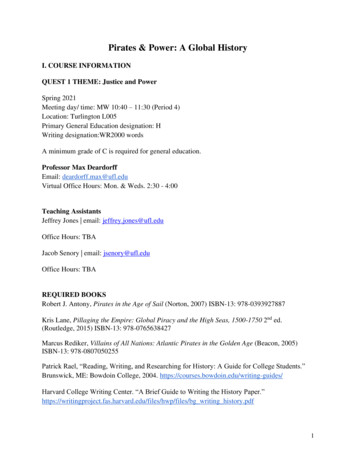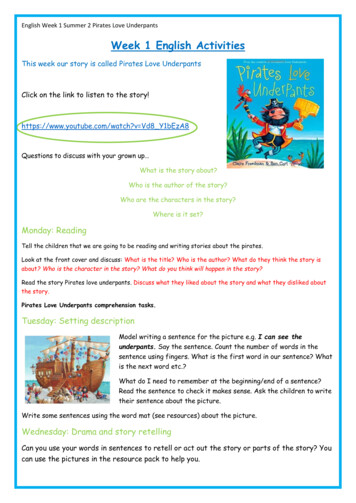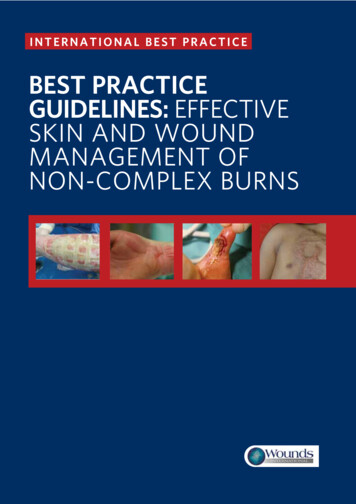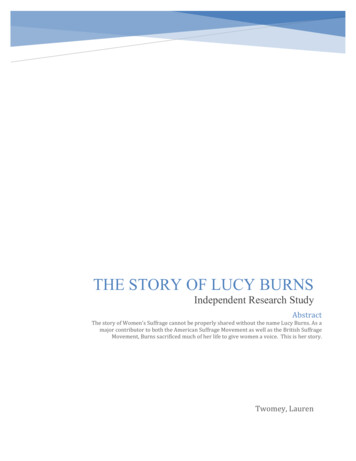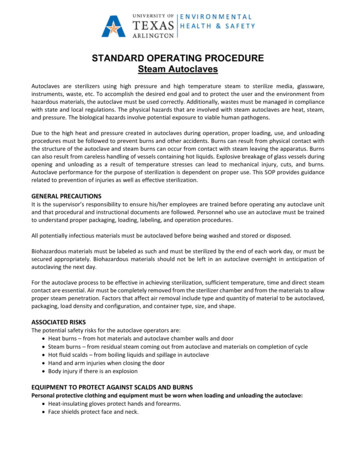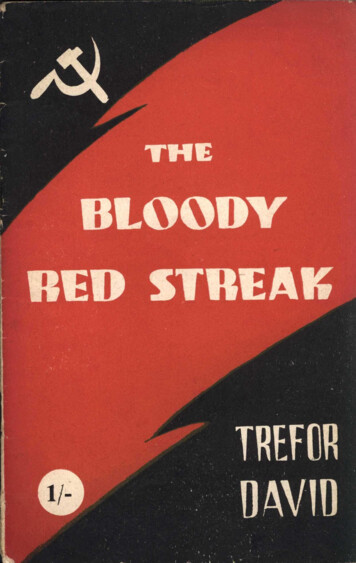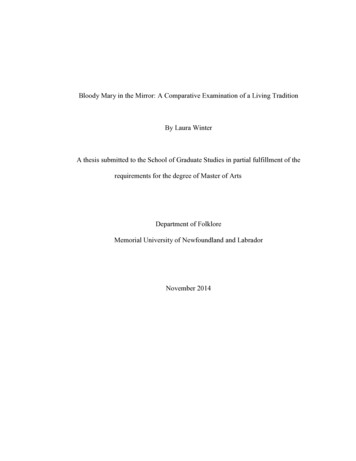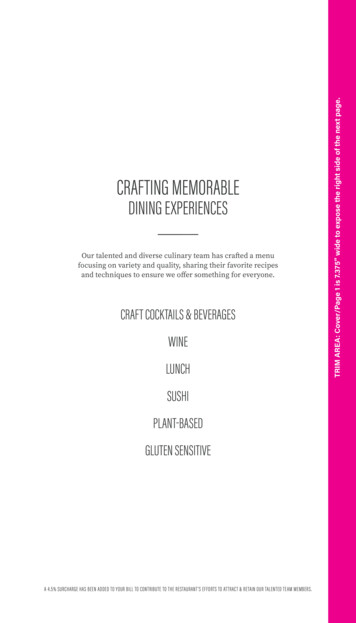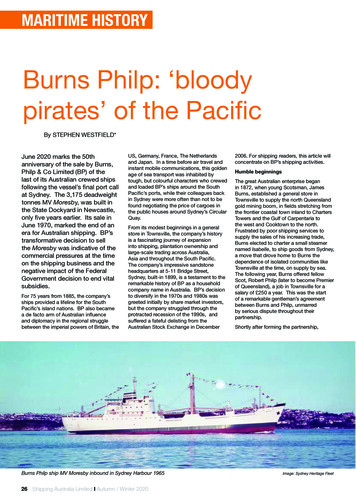
Transcription
MARITIME HISTORYBurns Philp: ‘bloodypirates’ of the PacificBy STEPHEN WESTFIELD*June 2020 marks the 50thanniversary of the sale by Burns,Philp & Co Limited (BP) of thelast of its Australian crewed shipsfollowing the vessel’s final port callat Sydney. The 3,175 deadweighttonnes MV Moresby, was built inthe State Dockyard in Newcastle,only five years earlier. Its sale inJune 1970, marked the end of anera for Australian shipping. BP’stransformative decision to sellthe Moresby was indicative of thecommercial pressures at the timeon the shipping business and thenegative impact of the FederalGovernment decision to end vitalsubsidies.For 75 years from 1885, the company’sships provided a lifeline for the SouthPacific’s island nations. BP also becamea de facto arm of Australian influenceand diplomacy in the regional strugglebetween the imperial powers of Britain, theUS, Germany, France, The Netherlandsand Japan. In a time before air travel andinstant mobile communications, this goldenage of sea transport was inhabited bytough, but colourful characters who crewedand loaded BP’s ships around the SouthPacific’s ports, while their colleagues backin Sydney were more often than not to befound negotiating the price of cargoes inthe public houses around Sydney’s CircularQuay.From its modest beginnings in a generalstore in Townsville, the company’s historyis a fascinating journey of expansioninto shipping, plantation ownership andlarge-scale trading across Australia,Asia and throughout the South Pacific.The company’s impressive sandstoneheadquarters at 5-11 Bridge Street,Sydney, built-in 1899, is a testament to theremarkable history of BP as a householdcompany name in Australia. BP’s decisionto diversify in the 1970s and 1980s wasgreeted initially by share market investors,but the company struggled through theprotracted recession of the 1990s, andsuffered a fateful delisting from theAustralian Stock Exchange in DecemberBurns Philp ship MV Moresby inbound in Sydney Harbour 196526 Shipping Australia Limited I Autumn / Winter 20202006. For shipping readers, this article willconcentrate on BP’s shipping activities.Humble beginningsThe great Australian enterprise beganin 1872, when young Scotsman, JamesBurns, established a general store inTownsville to supply the north Queenslandgold mining boom, in fields stretching fromthe frontier coastal town inland to ChartersTowers and the Gulf of Carpentaria tothe west and Cooktown to the north.Frustrated by poor shipping services tosupply the sales of his increasing trade,Burns elected to charter a small steamernamed Isabelle, to ship goods from Sydney,a move that drove home to Burns thedependence of isolated communities likeTownsville at the time, on supply by sea.The following year, Burns offered fellowScot, Robert Philp (later to become Premierof Queensland), a job in Townsville for asalary of 250 a year. This was the startof a remarkable gentleman’s agreementbetween Burns and Philp, unmarredby serious dispute throughout theirpartnership.Shortly after forming the partnership,Image: Sydney Heritage Fleet
INSTANT PRICING ATYOUR FINGERTIPSBooking has never been easier with MyPrices – simplylogin to your e-Business account, enter the POL, POD,required departure date and type of equipment. With asingle click, you will find your existing offer or receive aninstant quote. From here, you can place a booking directly– just like that!Login and book today!Autumn / Winter 2020 I Shipping Australia Limited 17
A friend in the business.Hamburg Süd.This is a special message to all our customers – present,and future. In challenging times like this, we can all do witha bit of friendly help. If you’re in a tight spot or need to backup a little. If you need to nudge things into a better positionmoving forward. Now more than ever you can look to us forgood advice and strong service support.Safe hands Hamburg Süd.No matter what.www.hamburgsud-line.comAutumn / Winter 2020 I Shipping Australia Limited 13
Burns was obliged to move to Sydneyafter suffering repeated bouts of malaria.Philp remained in Townsville to managethe general store and the continuingexpansion of the business in Queensland,while Burns grew cargo volumes fromSydney, and shipped supplies up the eastcoast to Townsville, and other Queenslandports. This marked the beginnings ofthe partnership’s regular coastal shippingservices. Burns became an expert inassessing ships and revelling in thebusiness of chartering, buying and sellingsmall vessels, while Philp presided over theexpansion of stores in the rapidly growingNorth Queensland economy, buoyed by thedevelopment of its mining, cattle and sugarindustries. The period was not withoutincident. In 1887, on the maiden voyage ofone of the earliest ships owned by Burns,the wooden steamer Banshee, shippinggoods between Townsville and Cooktown,ran aground and was wrecked with theloss of 20 lives. The disaster was a harshintroduction to the hazards of shipping.With the stores continuing to prosperthrough the late 1800s, Burns and Philpalso had grown their coastal shippingservices across New South Wales,Queensland, Victoria and Western Australia.This expansion continued to ThursdayIsland, with BP’s acquisition of a pearlshelling business. This led to supplyingthe industry, and then the next step ofinternational shipping into New Guinea.The partners’ first overseas store had beendecisive battles were fought in Europe, theoutcomes would have drastic impacts oncolonies in the Pacific Islands. Germanycontrolled substantial lands in the SouthPacific and was supported in the early1900s by Norddeutsher Lloyd. It lostground immediately after the start of WorldWar 1, however, when Australian troopsoccupied German New Guinea and thenearby Bismarck Archipelago. BP quicklyestablished a service to Rabaul on theisland of New Britain, and was supportedin its expansionary moves by winningAustralian Government subsidies to help itcompete with the flags of other nations.James BurnesImage: Sydney Heritage Fleetestablished by 1884 in Port Moresby, thenpart of British New Guinea. During thistime, BP ships began passenger servicesand started to market holiday voyages ontheir ships to the Pacific Islands.The South Pacific theatre and WWIIThroughout the early to mid-1900s, rivalimperial powers tussled for control andinfluence in the Pacific region, and theshipping lines of these countries supportedthe national imperial ambitions. WhilstFrench territories included New Caledonia,Tahiti, plus half share with Britain of theNew Hebrides (later Vanuatu) condominium.The Dutch, remaining neutral, had controlof the East Indies (modern Indonesia) andwestern New Guinea. British interestswere mainly Fiji, the Solomon Islands andprotectorate roles over the Gilbert andEllice Islands (now Kiribati and Tuvalu) andTonga, and its half share (with France) ofthe New Hebrides. The United States andJapan had keen interest too in the region.There was further complexity in the regionwith then British colonies Australia and NewZealand, also vying for regional influence.Japan’s NYK line ran services from NorthAsia, KPM was the leading Dutch shippingline in the region, and MessageriesMaritimes serviced the French colonies.Britain’s Bank Line was an active shipownerin the South Pacific on behalf of tradersDedicated to the safe and efficienthandling of cargo worldwideA full range of services: Sales and Marketing Vessel Husbandry and Crew Management and Control of Equipment Procurementof Terminal Services and other service providers Integrated systems with Customs, Port Authorities,Terminal Operators and service providers All local DocumentationOffering: Experienced and highly skilled staff Global network connections Total operational flexibility 24 hours a day,365 days per yearPAE is dedicated to the safe and efficient handlingof cargo worldwide by providing a high level oftailored service to meet all our customer needs.pae.com.auAgents for:Autumn / Winter 2020 I Shipping Australia Limited 27
Autumn / Winter 2020 I Shipping Australia Limited7
Autumn / Winter 2020 I Shipping Australia Limited 19
period of rapid growth in trade across thePacific, and 60 vessels at the peak. BPcontrolled a network of company storesand agencies across Australia, Papua NewGuinea, Vanuatu, the Solomon Islands,Norfolk and Lord Howe Islands, Kiribati andTuvalu, Fiji and Samoa. The key Australiato New Guinea trade was eventually takenover by The China Navigation Company in1952, with the beginning of New GuineaLine with services carrying the samecargoes. Burns Philp’s numerous storesscattered throughout PNG were eventuallysold to long-standing shipping competitorSteamships.Burns Philp ship MV Bululo docked at RabaulLever Brothers, buying copra and coconutoil for Lever’s European, US and Australianfactories. Amongst these foreign carriers,Burns Philp was both competitor andAustralian operator, leveraging its regionalbusinesses under the guise of alsoprotecting and strengthening Australia’sinterests.James Burns and influential Sydney-basedBP island manager, Walter Lucas, felt thatAustralia should control the South Pacific,and were particularly suspicious aboutGerman intentions.Throughout both major wars, BP vesselswere called on in the Pacific conflict tocarry supplies, personnel and ammunition.In World War II, eight company ships wererequisitioned and six were lost in enemyaction. One notable incident involving aBP vessel occurred when the MV Malaita,shipped troops and supplies into NewGuinea, and helped evacuate women andchildren following the outbreak of war withthe Japanese. Malaita survived a torpedofired by the Japanese submarine near thePort Moresby Harbour entrance on 23August 1942.Throughout WWII, BP mariners assistedallied forces in the Pacific with their vast,detailed knowledge of the channels, reefsand shoals. This knowledge, togetherwith their pilotage and guidance skills,proved invaluable (several BP captainsbeing decorated) as the “island-hopping”campaigns of the Allies pushed back theJapanese incursions.Shipping tradesBurns Philp was a mercantile tradingbusiness but was driven into shipping tosupport its business. Ironically, shippingbecame its main business. In the agebefore containerisation, the cargo wasshipped on pallets or loose. The Australiato New Guinea service, with two shipsproviding two sailings every three monthswas the central trade for BP up to 1970.Export cargo loaded in the Pacific includedagricultural commodities, largely copra, andImage: Sydney Heritage Fleetthese were often transhipped to Europe.Early BP ships had their own “tradingrooms” where merchandise was tradedfor island products, with the transactiontaking place on the ship. From 1920onwards, a subsidiary Burns Philp (SouthSeas), operated all shipping trades east ofAustralia and New Guinea into the Pacific,and inter-island cargoes to avoid Australia’strade union demands and the NavigationAct.Shipping in the Pacific was frequentlyunprofitable unless it included copratrading. The control of plantationsand supply was vital to BP’s services.Important trading partners of BPthroughout the Pacific were the numerousreligious missions, which required largequantities of cargo shipped for missionuse, as well as various revenue-earningbusiness interests. From the mid-1900s,BP grew rapidly in terms of its vessels andexpanding trading opportunities betweenAustralia and South East Asia. One of thelater trade routes of BP was Sydney to thePacific Islands and on to the West Coastof North America using prominent servicevessel MV Tulagi registered by Burns Philp(South Seas) Ltd Suva.What remains today of the company arethe numerous buildings in Australia andthroughout the Pacific, some of which areheritage-listed, including its former grandheadquarters on Bridge Street in Sydney’sCBD, and buildings in Townsville. Thelarge-scale trading and retail companiesthat were started by Burns Philp will ensurethe company is firmly ingrained into thehistory of Australian business, providinglivelihoods for thousands of employees anda lifeline for dozens of Pacific communities.Although it was exposed to taunts, albeitfriendly ones, about being “pirates”, BPplayed a key role in the growth in trade,communications and development ofAustralia and South Pacific nations. Itslegacy is a tribute to the vision of itsfounders, James Burns and Robert Philp,and an industrial example of the successthat can be achieved in a free enterprisesociety with vision, courage and resolve.A substantial share of Burns Philp’srevenue and history was generatedthrough passengers travelling on theirships in an era where people weren’t asrushed, and a voyage to the South Pacificwas an adventure. A testament to thefamiliarity of BP ships in the islands wasthe departure on its final voyage of SSBulolo (which had accommodation capacityfor 239 passengers) from Port Moresbyfor Australia, in January 1968. More than1,000 people gathered at the wharf tofarewell her on her last voyage.Burns Philp legacyFor more than 75 years, the vessels ofBurns Philp provided a lifeline for Australiancommunities and the South Pacific’s islandnations. Over that time, BP owned morethan 150 vessels, and at the peak of itsshipping business in the 1950s during the28 Shipping Australia Limited I Autumn / Winter 2020*Stephen Westfield is trade manager at Swire Shipping,chairman of Young Shipping Australia, New South Wales,and a director of the Australian Merchant Navy WarMemorial Fund.This article was first published in Daily Cargo News June2020 edition.
PAPUANEWINEAALANDAUSTRALIAZEPort by Port and Ship by Ship, we providefull port agency services through ourunique network. Our geographicalcoverage spans over 1500 different portlocations, supporting over 2500 diverseclients. Our local knowledge enables usto deliver quality services where they areneeded most, enabling our customers toship smoothly and trade successfully.GUEWOur services include:N Port Agency Liner Agency Husbandry Services Marine Survey and Inspection Bio-Fouling and Underwater Inspection Offshore Support Services Bunker Coordination Ship Maintenance Spares and Supplies Provisions and Stores Cash to Master Marine Survey and Inspection Medical Assistance Crew Movements and Logistics Disbursement Accounting Bunker Duty and Freight Tax Coastal LicenseAustraliaNew ZealandPapua New GuineaInchcape Shipping ServicesGround Floor, 120 Christie Street,St Leonards,NSW 2065Tel : 61 2 9410 8888Email : australia@iss-shipping.comISS-Mackay LtdThe Shipping Exchange2 Akaroa Street, Parnell,Auckland 1052Tel : 64 9 3094 266Email : auckland@iss-mckay.co.nzInchcape Shipping ServicesThe Shipping ExchangeLevel 5, Mogoru Moto BuildingChampion Parade, Port Moresby 121Tel: 675 321 2599Email : port.moresby@iss-shipping.comCONNECT TO A SMOOTHER, SMARTER OCEANwww.iss-shipping.comAutumn / Winter 2020 I Shipping Australia Limited 25Shipping Australia Limited Annual Review 2019 27
Autumn / Winter 2020 I Shipping Australia Limited 29
The best fit is the onetailored for youBespoke services to help you stand outWith 14 strategically located offices, GAC Australia has what it takes to serve your shipping needs for all typesof cargoes and vessels, at all ports and offshore terminals throughout the country. From traditional ship agencyto specialised services for bunkers, husbandry and crews, we measure and match our services to create thebest fit for your business strategy. Our continuous investment in new services and technologies keeps youbuttoned up to stay ahead of competitors.gac.com/australiaGulf Agency Company (Australia) Pty LtdT: 61 02 8028 2400F: 61 02 9279 0457E: shipping.australia@gac.comOur offices:Sydney (Main Office) I Port Kembla I Melbourne I Adelaide I Fremantle I Dampier I Port Hedland IDarwin I Townsville I Mackay I Gladstone I Brisbane I Newcastle I up
Burns elected to charter a small steamer named Isabelle, to ship goods from Sydney, a move that drove home to Burns the dependence of isolated communities like Townsville at the time, on supply by sea. The following year, Burns oered fellow Scot, Robert Philp (later to become Premier of Queensland), a job in Townsville for a salary of 250 a year.
